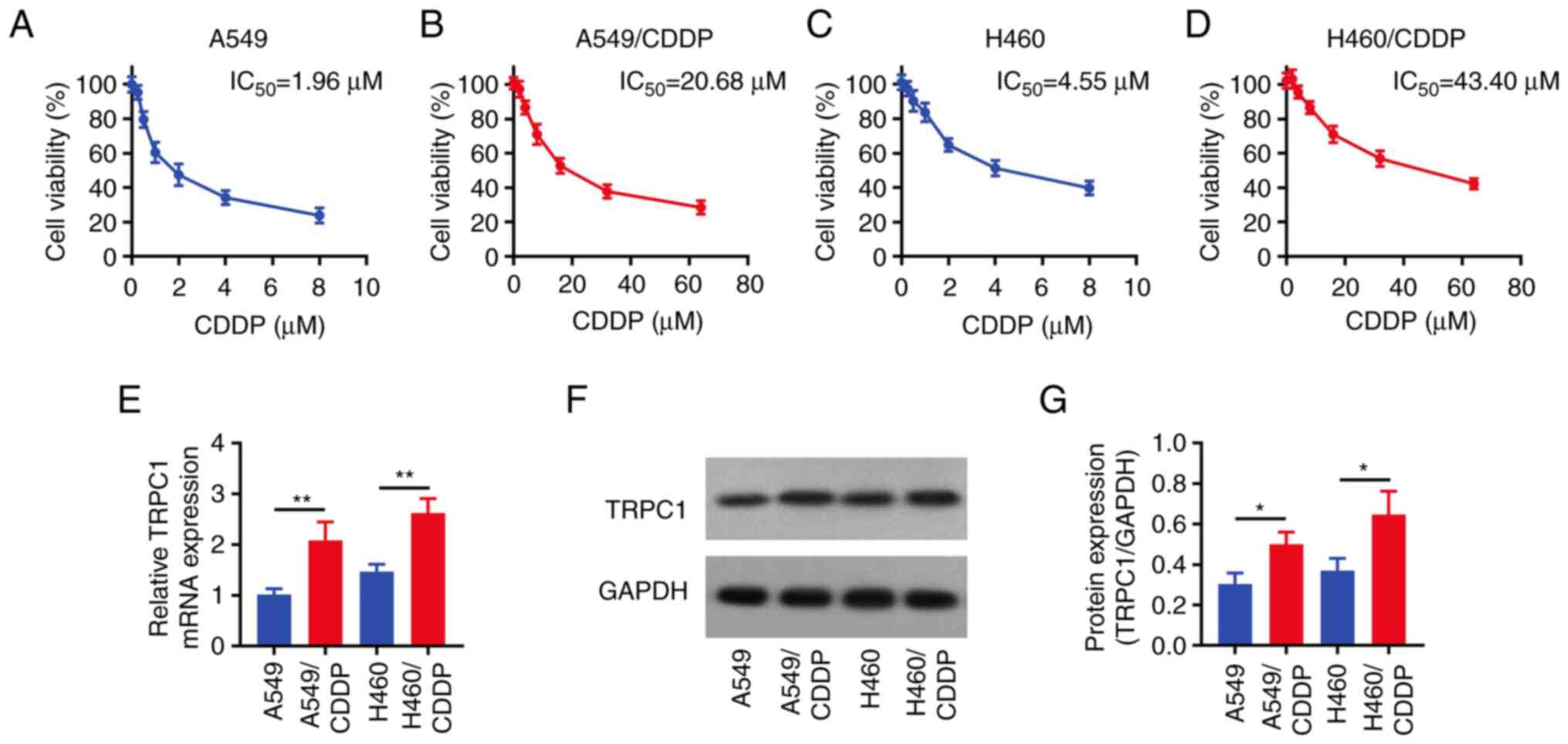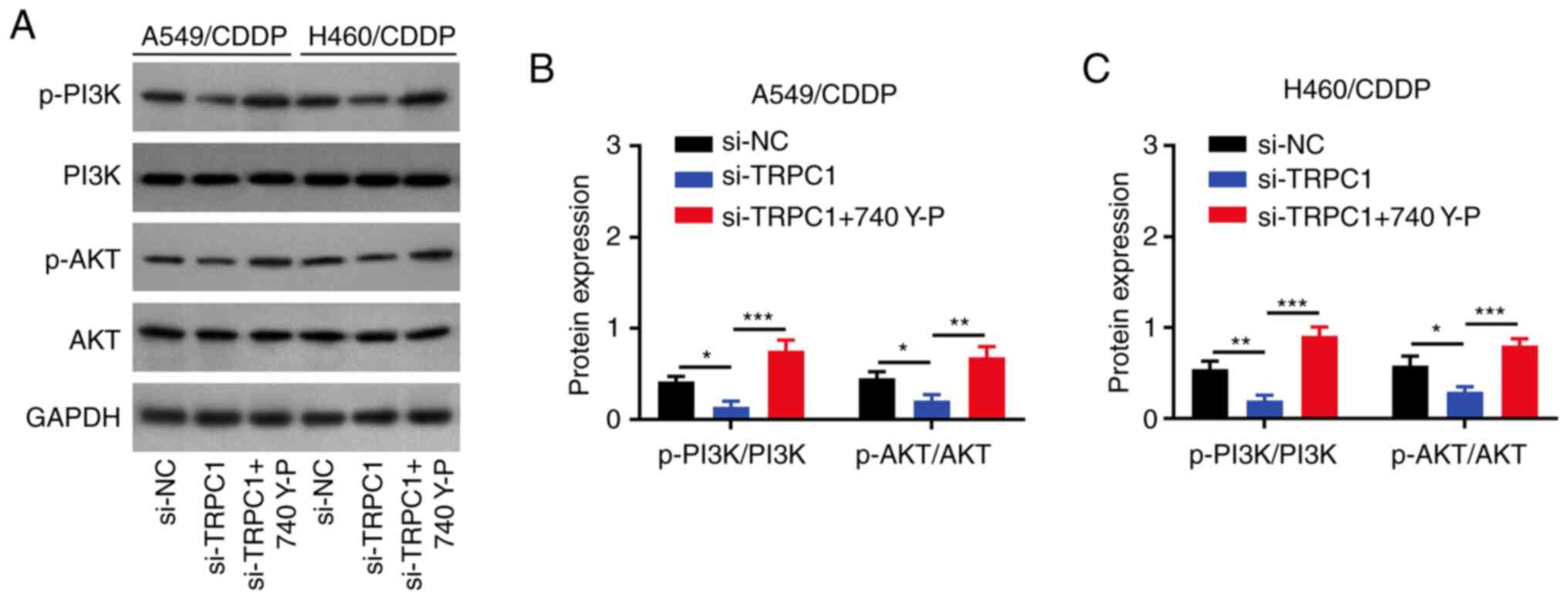|
1
|
Sung H, Ferlay J, Siegel RL, Laversanne M,
Soerjomataram I, Jemal A and Bray F: Global cancer statistics 2020:
GLOBOCAN estimates of incidence and mortality worldwide for 36
cancers in 185 countries. CA Cancer J Clin. 71:209–249. 2021.
View Article : Google Scholar : PubMed/NCBI
|
|
2
|
Thai AA, Solomon BJ, Sequist LV, Gainor JF
and Heist RS: Lung cancer. Lancet. 398:535–554. 2021. View Article : Google Scholar : PubMed/NCBI
|
|
3
|
Rodak O, Peris-Diaz MD, Olbromski M,
Podhorska-Okołów M and Dzięgiel P: Current landscape of non-small
cell lung cancer: Epidemiology, histological classification,
targeted therapies, and immunotherapy. Cancers (Basel).
13:47052021. View Article : Google Scholar : PubMed/NCBI
|
|
4
|
Shah P, Sands J and Normanno N: The
expanding capability and clinical relevance of molecular diagnostic
technology to identify and evaluate EGFR mutations in
advanced/metastatic NSCLC. Lung Cancer. 160:118–126. 2021.
View Article : Google Scholar : PubMed/NCBI
|
|
5
|
Chaft JE, Rimner A, Weder W, Azzoli CG,
Kris MG and Cascone T: Evolution of systemic therapy for stages
I–III non-metastatic non-small-cell lung cancer. Nat Rev Clin
Oncol. 18:547–557. 2021. View Article : Google Scholar : PubMed/NCBI
|
|
6
|
Fadejeva I, Olschewski H and Hrzenjak A:
MicroRNAs as regulators of cisplatin-resistance in non-small cell
lung carcinomas. Oncotarget. 8:115754–115773. 2017. View Article : Google Scholar : PubMed/NCBI
|
|
7
|
de Graeff A, Slebos RJ and Rodenhuis S:
Resistance to cisplatin and analogues: Mechanisms and potential
clinical implications. Cancer Chemother Pharmacol. 22:325–332.
1988. View Article : Google Scholar : PubMed/NCBI
|
|
8
|
Jing N, Gao WQ and Fang YX: Regulation of
formation, stemness and therapeutic resistance of cancer stem
cells. Front Cell Dev Biol. 9:6414982021. View Article : Google Scholar : PubMed/NCBI
|
|
9
|
Elzamzamy OM, Penner R and Hazlehurst LA:
The role of TRPC1 in modulating cancer progression. Cells.
9:3882020. View Article : Google Scholar : PubMed/NCBI
|
|
10
|
Baudel MASM, Shi J, Large WA and Albert
AP: Insights into activation mechanisms of store-operated TRPC1
channels in vascular smooth muscle. Cells. 9:1792020. View Article : Google Scholar : PubMed/NCBI
|
|
11
|
Van den Eynde C, De Clercq K, Van Bree R,
Luyten K, Annibali D, Amant F, Han S, Van Nieuwenhuysen E, Baert T,
Peeraer K, et al: TRP channel expression correlates with the
epithelial-mesenchymal transition and high-risk endometrial
carcinoma. Cell Mol Life Sci. 79:262021. View Article : Google Scholar : PubMed/NCBI
|
|
12
|
Tai YK, Chan KKW, Fong CHH, Ramanan S, Yap
JLY, Yin JN, Yip YS, Tan WR, Koh APF, Tan NS, et al: Modulated
TRPC1 expression predicts sensitivity of breast cancer to
doxorubicin and magnetic field therapy: Segue towards a precision
medicine approach. Front Oncol. 11:7838032022. View Article : Google Scholar : PubMed/NCBI
|
|
13
|
De Las Rivas J, Brozovic A, Izraely S,
Casas-Pais A, Witz IP and Figueroa A: Cancer drug resistance
induced by EMT: Novel therapeutic strategies. Arch Toxicol.
95:2279–2297. 2021. View Article : Google Scholar : PubMed/NCBI
|
|
14
|
Pan C, Jin L, Wang X, Li Y, Chun J, Boese
AC, Li D, Kang HB, Zhang G, Zhou L, et al: Inositol-triphosphate
3-kinase B confers cisplatin resistance by regulating
NOX4-dependent redox balance. J Clin Invest. 129:2431–2445. 2019.
View Article : Google Scholar : PubMed/NCBI
|
|
15
|
Tian S, Lou L, Tian M, Lu G, Tian J and
Chen X: MAPK4 deletion enhances radiation effects and triggers
synergistic lethality with simultaneous PARP1 inhibition in
cervical cancer. J Exp Clin Cancer Res. 39:1432020. View Article : Google Scholar : PubMed/NCBI
|
|
16
|
Wang J, Liang J, Li H, Han J, Jiang J, Li
Y, Feng Z, Zhao R and Tian H: Oncogenic role of abnormal
spindle-like microcephaly-associated protein in lung
adenocarcinoma. Int J Oncol. 58:232021. View Article : Google Scholar : PubMed/NCBI
|
|
17
|
Livak KJ and Schmittgen TD: Analysis of
relative gene expression data using real-time quantitative PCR and
the 2(−Delta Delta C(T)) method. Methods. 25:402–408. 2001.
View Article : Google Scholar : PubMed/NCBI
|
|
18
|
Nesin V and Tsiokas L: TRPC1. Handb Exp
Pharmacol. 222:15–51. 2014. View Article : Google Scholar : PubMed/NCBI
|
|
19
|
Zeng YZ, Zhang YQ, Chen JY, Zhang LY, Gao
WL, Lin XQ, Huang SM, Zhang F and Wei XL: TRPC1 inhibits cell
proliferation/invasion and is predictive of a better prognosis of
esophageal squamous cell carcinoma. Front Oncol. 11:6277132021.
View Article : Google Scholar : PubMed/NCBI
|
|
20
|
Bomben VC, Turner KL, Barclay TT and
Sontheimer H: Transient receptor potential canonical channels are
essential for chemotactic migration of human malignant gliomas. J
Cell Physiol. 226:1879–1888. 2011. View Article : Google Scholar : PubMed/NCBI
|
|
21
|
Zhang Z, Ren L, Zhao Q, Lu G, Ren M, Lu X,
Yin Y, He S and Zhu C: TRPC1 exacerbate metastasis in gastric
cancer via ciRS-7/miR-135a-5p/TRPC1 axis. Biochem Biophys Res
Commun. 529:85–90. 2020. View Article : Google Scholar : PubMed/NCBI
|
|
22
|
Tajeddine N and Gailly P: TRPC1 protein
channel is major regulator of epidermal growth factor receptor
signaling. J Biol Chem. 287:16146–16157. 2012. View Article : Google Scholar : PubMed/NCBI
|
|
23
|
Jiang HN, Zeng B, Zhang Y, Daskoulidou N,
Fan H, Qu JM and Xu SZ: Involvement of TRPC channels in lung cancer
cell differentiation and the correlation analysis in human
non-small cell lung cancer. PLoS One. 8:e676372013. View Article : Google Scholar : PubMed/NCBI
|
|
24
|
Hasna J, Hague F, Rodat-Despoix L, Geerts
D, Leroy C, Tulasne D, Ouadid-Ahidouch H and Kischel P: Orai3
calcium channel and resistance to chemotherapy in breast cancer
cells: The p53 connection. Cell Death Differ. 25:693–707. 2018.
View Article : Google Scholar : PubMed/NCBI
|
|
25
|
Tang BD, Xia X, Lv XF, Yu BX, Yuan JN, Mai
XY, Shang JY, Zhou JG, Liang SJ and Pang RP: Inhibition of
Orai1-mediated Ca2+ entry enhances chemosensitivity of
HepG2 hepatocarcinoma cells to 5-fluorouracil. J Cell Mol Med.
21:904–915. 2017. View Article : Google Scholar : PubMed/NCBI
|
|
26
|
Sukumaran P, Sun Y, Antonson N and Singh
BB: Dopaminergic neurotoxins induce cell death by attenuating
NF-κB-mediated regulation of TRPC1 expression and autophagy. FASEB
J. 32:1640–1652. 2018. View Article : Google Scholar : PubMed/NCBI
|
|
27
|
Usman RM, Razzaq F, Akbar A, Farooqui AA,
Iftikhar A, Latif A, Hassan H, Zhao J, Carew JS, Nawrocki ST and
Anwer F: Role and mechanism of autophagy-regulating factors in
tumorigenesis and drug resistance. Asia Pac J Clin Oncol.
17:193–208. 2021. View Article : Google Scholar : PubMed/NCBI
|
|
28
|
Ma S, Kong D, Fu X, Liu L, Liu Y, Xue C,
Tian Z, Li L and Liu X: p53-induced autophagy regulates
chemotherapy and radiotherapy resistance in multidrug resistance
cancer cells. Dose Response. 19:155932582110480462021. View Article : Google Scholar : PubMed/NCBI
|
|
29
|
Galluzzi L, Senovilla L, Vitale I, Michels
J, Martins I, Kepp O, Castedo M and Kroemer G: Molecular mechanisms
of cisplatin resistance. Oncogene. 31:1869–1883. 2012. View Article : Google Scholar : PubMed/NCBI
|
|
30
|
Barbato L, Bocchetti M, Di Biase A and
Regad T: Cancer stem cells and targeting strategies. Cells.
8:9262019. View Article : Google Scholar : PubMed/NCBI
|
|
31
|
Yao W, Wang L, Huang H, Li X, Wang P, Mi
K, Cheng J, Liu H, Gu C, Huang L and Huang J: All-trans retinoic
acid reduces cancer stem cell-like cell-mediated resistance to
gefitinib in NSCLC adenocarcinoma cells. BMC Cancer. 20:3152020.
View Article : Google Scholar : PubMed/NCBI
|
|
32
|
Pan G, Liu Y, Shang L, Zhou F and Yang S:
EMT-associated microRNAs and their roles in cancer stemness and
drug resistance. Cancer Commun (Lond). 41:199–217. 2021. View Article : Google Scholar : PubMed/NCBI
|
|
33
|
Xu F, Liu XC, Li L, Ma CN and Zhang YJ:
Effects of TRPC1 on epithelial mesenchymal transition in human
airway in chronic obstructive pulmonary disease. Medicine
(Baltimore). 96:e81662017. View Article : Google Scholar : PubMed/NCBI
|
|
34
|
Zanou N, Schakman O, Louis P, Ruegg UT,
Dietrich A, Birnbaumer L and Gailly P: Trpc1 ion channel modulates
phosphatidylinositol 3-kinase/Akt pathway during myoblast
differentiation and muscle regeneration. J Biol Chem.
287:14524–14534. 2012. View Article : Google Scholar : PubMed/NCBI
|
















